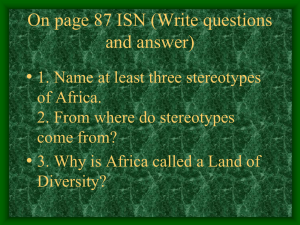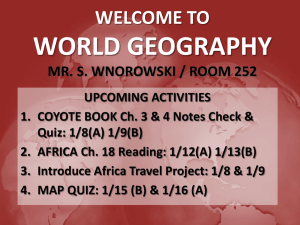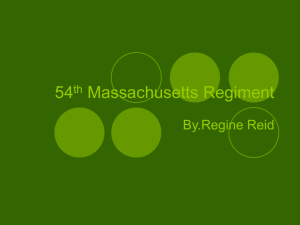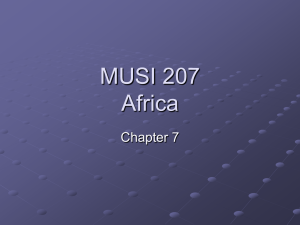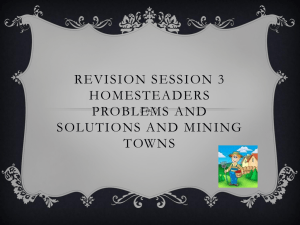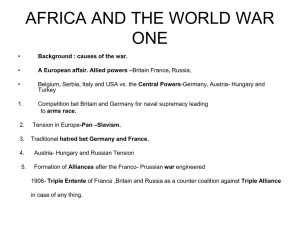Geography of Africa Chapters 1 & 2 Test Review
advertisement
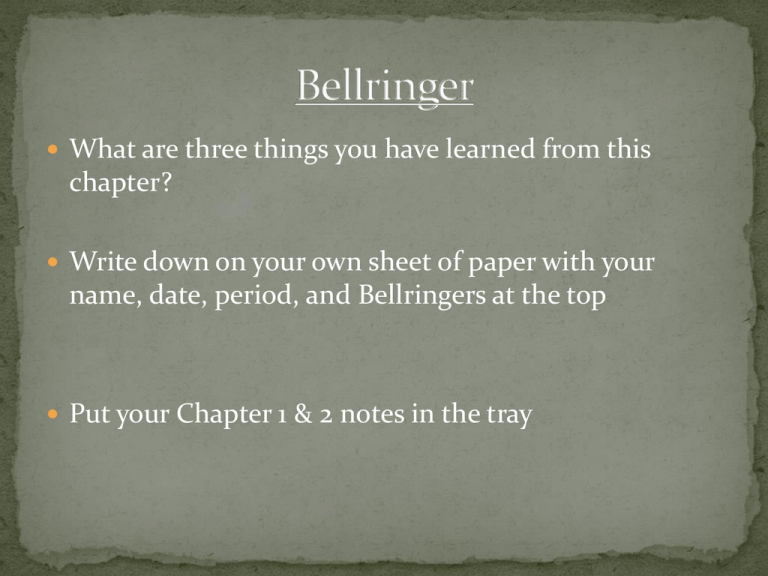
What are three things you have learned from this chapter? Write down on your own sheet of paper with your name, date, period, and Bellringers at the top Put your Chapter 1 & 2 notes in the tray What are the four main rivers of Africa? Put your completed Bellringers in the tray Get your notes in the correct order, staple, and name on them to turn in Monday before your test Ch. 1-1 (Graphic Organizer) Ch. 1-3 (Graphic Organizer) Ch. 2-1 (Graphic Organizer) Ch. 2-2 (Chart of African Kingdoms) Ch. 2-3 (Graphic Organizer) Ch. 2-5 (Graphic Organizer 1. Because the land area of much of Africa is high, the continent is often called the Coastal plain continent B. Mountain continent C. Plateau continent D. River valley continent A. 2. Why is it impossible for ships to sail from Africa’s interior to the sea? Waterfalls or rapids interrupt the rivers’ flow B. Mountains interrupt the rivers’ flow C. Rift valleys interrupt the rivers flow D. Tributaries interrupt the rivers’ flow A. 3. The Nile, the Congo, the Zambezi, and the Niger are the names of major Mountains in Africa B. Rivers in Africa C. Coastal plains in Africa D. Rift valleys in Africa A. 4. Africa’s location near the Equator, its elevation, and its relationship to large bodies of water and landforms affect its Language B. Government C. Archaeology D. Climate A. 5. The landform that extends across most of North Africa is The Sahara B. The Namib Desert C. The Nile River D. Mount Kilimanjaro A. 6. What area of land supports tall grasses, thorny bushes, and scattered trees? Coastal plain B. Desert C. Rain forest D. Savanna A. 7. Because much of Africa is between the Tropic of Cancer and the Tropic of Capricorn, most of the country is located in a Moderate climate region B. Subtropical climate region C. Tropical climate region D. Temperate climate region A. 8. How do many nomads make their living in the Sahara? They live in one place so they can care for their herds B. They live in the cities where they can sell their goods C. They travel to find water and food for their herds D. They create large farms in the desert to grow food A. 9. The four geographic regions of Africa are South, East, North, and Central and Eastern B. Northeast, South, Central and South, and East C. North, West, East, and Central and Southern D. North, South, East, and West A. 10. The majority of Africa’s farmland is used for Harvesting trees B. Cash crops C. Commercial farming D. Subsistence farming A. 11. Most of Africa’s workers are employed in Trading B. Mining C. Farming D. Manufacturing A. 12. Unlike farmers who raise cash crops, subsistence farmers raise crops to Sell to Western countries B. Support entire villages C. Support their families D. Sell to other African countries A. 13. Why did Europeans build empires in Africa after the end of the African slave trade? For the natural resources found there B. To redesign African borders C. To unite the African people D. Because they were overcrowded in Europe A. 14. Africa’s most important natural resources are Electricity and trade B. Crops, minerals, and timber C. Manufacturing, trade, and crops D. Solar energy, trade, and timber A. 15. Which European country controlled the trade of East Africa’s coast until well into the 1600s? England B. Spain C. France D. Portugal A. 16. How do producing a variety of crops, raw materials, and manufactured goods affect African countries? They can afford to buy equipment for mining B. They can protect their economies in an unstable world market C. They cannot protect themselves if a major cash crop fails D. They cannot survive a serious drought A. 17. The power of West African kingdoms was based on The herding of sheep and cows B. The trade of gold for salt C. The manufacturing of clothing D. The farming of oats and wheat A. 18. The earliest humans in East Africa got their food by Hunting and gathering B. Trading and hunting C. Domesticating and herding D. Farming and gathering A. 19. The earliest people in Egypt settled In the mountains B. Near the coast C. Along the banks of the Nile River D. in the Sahara A. 20. In order to win independence from the colonial powers, African leaders encouraged the growth of Religion B. Farming C. Nationalism D. Trade A. 21. By the 1600s, Portuguese traders were trading Gold for African salt B. Guns for enslaved Africans C. Clothing for African crops D. Salt for African guns A. 22. How did World War II affect Africa? It inspired African’s to demand their independence B. It increased trade between Africa and the U.S. C. It decreased the growth of cash crops D. It encouraged European countries to seize more African colonies A. 23. Islam was spread from Mali into many other parts of Africa by British soldiers B. Muslim traders C. Arab farmers D. Portuguese sailors A. 24. In order to depend less on one export, African countries are trying to Decrease their exports B. Diversity their economies C. Increase their foreign debt D. Expand their farm communities A. 25. One important effect of trade on the culture of coastal East Africa was the development of Buddhism B. Christianity C. Farming D. Swahili A. 26. A serious environmental problem facing Africa today is a decrease in the Crop harvests B. Size of the desert C. Amount of fertile land D. Number of trees that are planted A. 27. What is a civilization that arose on the Nile River about 5,000 years ago? South Africa B. Nigeria C. Egypt D. Senegal A. Make sure you can identify on a map: -Atlantic Ocean - Indian Ocean - Mediterranean Sea - Red Sea - Sahara - Namib - Kalahari - Nile River - Congo River - Niger River - Zambezi River - Atlas Mountains - Congo Basin - Great Rift Valley



